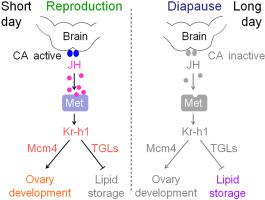Insect Biochemistry and Molecular Biology ( IF 3.2 ) Pub Date : 2021-04-24 , DOI: 10.1016/j.ibmb.2021.103582 Shuang Guo 1 , Qing-Wen Wu 1 , Zhong Tian 1 , Li Zhu 1 , Kirst King-Jones 2 , Fen Zhu 1 , Xiao-Ping Wang 1 , Wen Liu 1

|
Many insects exhibit reproductive plasticity where the photoperiod determines whether the insect becomes reproductively active or enters diapause. Adult reproductive diapause is a strategy that allows insects to survive harsh environmental conditions. A deficiency in juvenile hormone (JH) leads to reproductive diapause. However, little is known about the molecular mechanisms by which JH signaling regulates reproductive diapause. In this study, we used the cabbage beetle Colaphellus bowringi, a serious pest, to investigate the role of Krüppel homolog 1 (Kr-h1) in controlling photoperiodic plasticity of female reproduction. We focused on Kr-h1, since it acts as a key mediator of JH signaling. We show here that JH-Methoprene-tolerant signaling upregulated the expression of Kr-h1 in reproductively active C. bowringi females when reared under short day conditions. In the long day-treated diapausing females, Kr-h1 transcripts decreased dramatically. Interfering with Kr-h1 function repressed reproductive development by blocking vitellogenesis and ovarian growth. Further, Kr-h1 depletion induced other diapause-like traits, including elevated lipid accumulation and high expression of diapause-related genes. RNA-Seq showed that Kr-h1 played both activating and repressive roles, depending on whether downstream genes were acting in reproduction- or diapause pathways, respectively. Finally, we identified the DNA replication gene mini-chromosome maintenance 4 and two triacylglycerol lipase genes as critical downstream factors of Kr-h1 that are critical for reproductive plasticity in C. bowringi. These results reveal that Kr-h1 is a key component of the regulatory pathway that coordinates reproduction and diapause in insects in response to photoperiodic input.
中文翻译:

Krüppel 同源物 1 调节甘蓝甲虫 Colaphellus bowringi 的光周期生殖可塑性
许多昆虫表现出生殖可塑性,其中光周期决定了昆虫是变得繁殖活跃还是进入滞育状态。成虫生殖滞育是一种使昆虫能够在恶劣的环境条件下生存的策略。保幼激素 (JH)缺乏会导致生殖滞育。然而,关于 JH 信号调节生殖滞育的分子机制知之甚少。在本研究中,我们使用严重害虫甘蓝甲虫Colaphellus bowringi来研究Krüppel同源基因1 ( Kr-h1 ) 在控制雌性生殖光周期可塑性中的作用。我们专注于Kr-h1,因为它充当 JH 信号的关键中介。我们在此表明,在短日照条件下饲养时,JH-甲氧戊二烯耐受信号上调了生殖活跃的C. bowringi雌性中Kr-h1的表达。在长日处理滞育雌性中,Kr-h1转录物急剧下降。干扰Kr-h1功能通过阻止卵黄生成和卵巢生长抑制生殖发育。此外,Kr-h1耗竭诱导了其他滞育样特征,包括脂质积累升高和滞育相关基因的高表达。RNA-Seq 显示Kr-h1发挥激活和抑制作用,具体取决于下游基因是否分别在繁殖或滞育途径中起作用。最后,我们将 DNA 复制基因微型染色体维持 4和两个三酰甘油脂肪酶基因鉴定为Kr-h1 的关键下游因子,它们对鲍林氏梭菌的生殖可塑性至关重要。这些结果表明,Kr-h1是响应光周期输入而协调昆虫繁殖和滞育的调控途径的关键组成部分。


















































 京公网安备 11010802027423号
京公网安备 11010802027423号